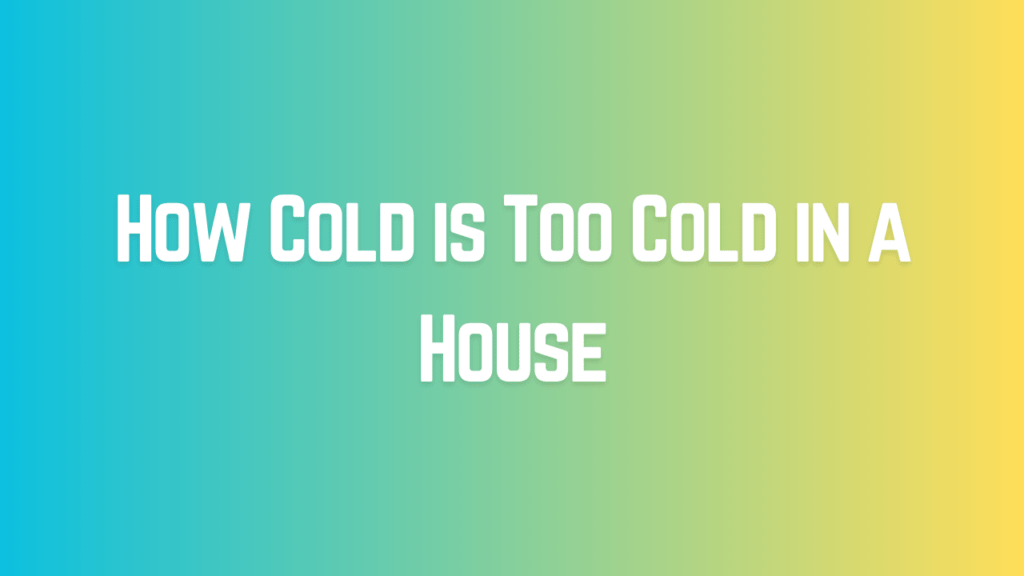
How Cold is Too Cold in a House? Discover the ideal indoor temperature range to ensure comfort and energy efficiency in your home. Learn when it’s too cold and how to maintain a cozy environment.
When it comes to the comfort of your home, maintaining the right temperature is paramount. But what exactly is the ideal indoor temperature, and when does it become too cold? In this article, we’ll delve into the science of indoor climate control to help you strike the perfect balance between comfort and energy efficiency.
How Cold is Too Cold in a House?
The ideal indoor temperature in a house typically ranges between 68 to 72 degrees Fahrenheit (20 to 22 degrees Celsius) for comfort and energy efficiency. However, what’s considered “too cold” can vary from person to person. Generally, if the indoor temperature drops below 60 degrees Fahrenheit (15 degrees Celsius), it may be too cold for most people’s comfort, and the risk of issues like frozen pipes or discomfort increases significantly.
Understanding the Ideal Indoor Temperature Range
We first need to establish the ideal indoor temperature range to determine how cold is too cold in a house. The consensus among experts is that the optimal temperature for most indoor spaces falls between 68°F (20°C) and 72°F (22°C). You’ll likely feel comfortable and enjoy a cozy atmosphere within this range.
However, individual preferences can vary. Personal comfort, clothing, and activity levels also affect your perception of temperature. Some people may feel comfortable at slightly cooler temperatures, while others prefer it a bit warmer. Finding the sweet spot that suits you and your household is essential.
When Does It Become Too Cold?
Now, let’s address when it’s too cold inside your home. Generally, if the indoor temperature drops below 60°F (15°C), most people will feel chilly and uncomfortable. Below 55°F (13°C), you may find it difficult to stay warm, and prolonged exposure to such temperatures can have adverse health effects, especially for vulnerable individuals like the elderly and children.
Furthermore, allowing your home to become too cold can lead to potential issues with your plumbing, as pipes may freeze and burst in extremely low temperatures. This can result in costly repairs and water damage.
How to Maintain a Cozy Environment
To prevent your home from becoming uncomfortably cold, here are some practical tips:
Proper Insulation: Ensure your home is well-insulated to prevent heat loss. Insulate walls, attics, and windows to maintain a consistent indoor temperature.
Regular Heating Maintenance: Schedule regular maintenance for your heating system to keep it operating efficiently. A well-maintained system will heat your home more effectively.
Use Programmable Thermostats: Install programmable thermostats to regulate your indoor temperature efficiently. You can lower the temperature while you’re away and raise it when you return.
Seal Drafts: Check for drafts around windows and doors and seal them to prevent cold air from entering your home.
Layer Clothing: Encourage family members to layer clothing during colder months to stay warm without drastically increasing the thermostat.
Consider Zone Heating: If possible, use zone heating to heat specific areas of your home, allowing you to focus on the rooms you use most.
In Conclusion
How Cold is Too Cold in a House? Determining how cold is too cold in a house largely depends on individual comfort levels, but generally, it’s advisable to keep your indoor temperature above 60°F (15°C) to ensure comfort and avoid potential issues. Proper insulation, regular heating maintenance, and smart temperature management are key to maintaining a cozy and energy-efficient home environment. By following these guidelines, you can enjoy a comfortable home no matter how cold it gets outside.
